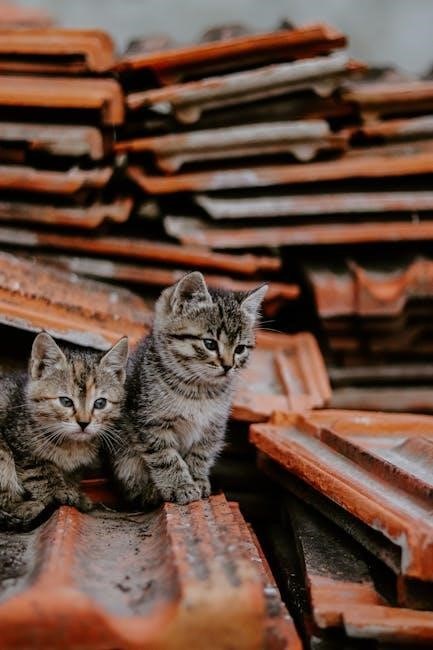Title and Author
The play Cat on a Hot Tin Roof, written by renowned American playwright Tennessee Williams, is a significant work in American literature, known for its exploration of themes like decay and human sexuality.
1.1 The Title: “Cat on a Hot Tin Roof”
The title Cat on a Hot Tin Roof is a vivid metaphor that reflects the emotional turmoil and desperation of the characters. Originating from Tennessee Williams’ play, the title symbolizes the discomfort and anxiety of being in an unbearable situation, much like Maggie’s relentless pursuit to save her marriage. The “cat” represents Maggie, who feels trapped and restless, while the “hot tin roof” signifies the intense tension and underlying conflicts within the Pollitt family. This title encapsulates the play’s themes of decay, desire, and deception, setting the tone for a dramatic exploration of human frailty and societal expectations. Its imagery has become iconic in American literature.
1.2 The Author: Tennessee Williams
Tennessee Williams, a Pulitzer Prize-winning playwright, is one of the most influential figures in American literature; Born on March 26, 1911, in Columbus, Mississippi, Williams is renowned for his deep exploration of human psychology and societal issues. His works, such as A Streetcar Named Desire and The Glass Menagerie, are celebrated for their emotional intensity and complex characters. Williams’ writing often reflects his Southern upbringing and personal struggles, infusing his plays with authenticity and raw emotion. Cat on a Hot Tin Roof, written in 1955, is a testament to his mastery of dramatic tension and character development, solidifying his legacy as a literary giant. His plays remain widely studied and performed today, with PDF versions of his works, including Cat on a Hot Tin Roof, readily available for readers worldwide.
Plot Summary
The play revolves around the dysfunctional Pollitt family, exploring their secrets, lies, and tensions during Big Daddy’s birthday. Maggie’s efforts to secure the family’s future clash with Brick’s emotional detachment, unraveling their strained relationship and the family’s decaying values.
2.1 Setting of the Play
The setting of Cat on a Hot Tin Roof is primarily the Pollitt family’s Mississippi Delta plantation. The story unfolds in a single room of the plantation house during Big Daddy’s birthday celebration. This confined space intensifies the emotional tension among the characters. The decaying grandeur of the plantation mirrors the moral and familial decay within the family. The Southern setting is crucial, as it reflects the societal norms and expectations of the 1950s, which play a significant role in shaping the characters’ actions and conflicts.
2.2 Main Characters
The main characters in Cat on a Hot Tin Roof are deeply complex and interconnected. Maggie “The Cat” Pollitt is a determined and manipulative wife, desperate to secure her place in the family. Her husband, Brick Pollitt, is a former football star turned alcoholic, grappling with guilt and disinterest in Maggie. Big Daddy, the wealthy patriarch, is dying and aware of the family’s deceit. Big Mama, his wife, is oblivious to the tensions and focused on maintaining the family’s image. These characters drive the play’s exploration of lies, desire, and power struggles within the dysfunctional Pollitt family.
2.3 Key Themes and Conflicts
The play explores themes of decay, corruption, and the illusion of morality. Central conflicts arise from Brick’s alcoholism and emotional detachment, Maggie’s desperate attempts to secure her future, and Big Daddy’s terminal illness, which exposes the family’s lies. Sexual tension and unspoken desires further complicate relationships, particularly between Maggie and Brick. The struggle for control of the plantation escalates tensions, revealing deep-seated resentments and power struggles. These conflicts highlight the decay of Southern aristocracy and the moral hypocrisy within the Pollitt family, driving the play’s dramatic tension and emotional depth.

Themes and Motifs
The play explores themes of decay, corruption, and illusion, with motifs of sexuality, deception, and the struggle for power, reflecting the tension between truth and appearances.
3.1 The Theme of Decay and Corruption
Tennessee Williams masterfully portrays decay and corruption in Cat on a Hot Tin Roof, reflecting the moral and emotional decline of the Pollitt family. The once-thriving plantation, now tainted by greed and secrets, symbolizes the rot beneath the Southern aristocracy’s facade; Big Daddy’s illness and the family’s scramble for his wealth highlight the decay of values. Brick’s self-destructive alcoholism and Maggie’s desperate schemes further illustrate the corrosion of their relationships. This theme underscores the disintegration of social and familial structures, revealing the hollow core beneath the seeming prosperity of their lives.
3.2 The Theme of Sexuality and Desire
Cat on a Hot Tin Roof explores the complex and often repressed nature of sexuality and desire through its characters. Maggie’s overt sensuality and her longing for Brick contrast sharply with his emotional detachment and refusal to engage physically. The tension between them highlights the destructive power of unfulfilled desires. Brick’s inner turmoil, partly rooted in his past relationship with Skipper, further complicates the narrative, suggesting a deeper exploration of sexual identity. Williams uses these dynamics to critique societal norms, revealing how suppressed desires can lead to emotional turmoil and conflict. This theme remains central to the play’s psychological depth and character-driven drama.
3.3 The Theme of Lies and Deception
Lies and deception are pervasive in Cat on a Hot Tin Roof, driving the characters’ interactions and conflicts. Maggie’s manipulative charm and her fabricated stories about Brick’s past are central to her efforts to secure her place within the family. Similarly, Brick’s avoidance of reality and his refusal to confront his feelings for Skipper reveal a deeper self-deception. The Pollitt family’s collective denial of Big Daddy’s terminal illness further underscores the theme. Williams uses these elements to illustrate how lies can both bind and destroy relationships, creating a web of tension and mistrust that ultimately leads to emotional collapse and revelation.
3.4 The Motif of the “Cat on a Hot Tin Roof”
The title motif, “Cat on a Hot Tin Roof,” symbolizes Maggie’s precarious situation. Like the cat, she is desperate, clinging to a shaky surface, and in constant danger of falling. Her marriage to Brick is strained, and her efforts to maintain it are as futile as the cat’s attempts to stay balanced. This motif reflects her struggle for survival and acceptance, highlighting her determination and resilience. The imagery serves as a metaphor for the instability and tension within the Pollitt family, underscoring the fragility of their relationships and the inevitable confrontations that arise when secrets and lies are exposed.
Symbolism
Cat on a Hot Tin Roof is rich in symbolism; The title itself represents Maggie’s desperation and instability. The plantation symbolizes decaying Southern traditions, while Brick’s injury reflects his inner turmoil.
4.1 The Symbolism of the Title
The title Cat on a Hot Tin Roof symbolizes Maggie’s precarious emotional state. Like a cat on a scorching surface, she feels trapped, desperate, and constantly seeking escape. The imagery reflects her struggle to maintain her marriage and social standing amidst underlying tensions. The “hot tin roof” also alludes to the simmering conflicts within the Pollitt family, suggesting a volatile environment where emotions are on the brink of erupting. Williams uses this metaphor to highlight themes of instability, desire, and the fragility of human relationships, setting the tone for the play’s dramatic unfolding.
4.2 The Symbolism of the Plantation
The plantation in Cat on a Hot Tin Roof symbolizes tradition, family legacy, and the decaying values of the Old South. It serves as both a physical and emotional backdrop for the play’s events, representing a world on the brink of collapse. The plantation’s grandeur contrasts with the moral and financial decay of the Pollitt family, highlighting their internal conflicts and hypocrisy. It also symbolizes entrapment, as characters like Maggie and Brick feel confined by their circumstances. The plantation’s faded glory mirrors the characters’ struggles with identity and societal expectations, emphasizing the tension between illusion and reality in their lives. This setting underscores Williams’ exploration of human frailty and the decline of Southern aristocracy.
4.3 The Symbolism of Brick’s Injury
Brick’s physical injury, a broken ankle, serves as a potent symbol for his emotional and psychological state. His inability to run or escape mirrors his avoidance of the past and his suppressed desires. The injury also reflects his inner moral and psychological imbalance, as he struggles with his identity and relationships. The limp he carries symbolizes a deeper emotional paralysis, highlighting his inability to confront reality or move forward. This physical impairment underscores the themes of decay and evasion prevalent in the play, linking Brick’s personal turmoil to the broader familial and societal dysfunction. His injury becomes a visual reminder of his internal conflict and withdrawal from life.

Character Analysis
The play explores complex characters like Maggie the Cat, Brick Pollitt, Big Daddy, and Big Mama, each embodying distinct traits that drive the narrative and thematic depth.
5.1 Maggie the Cat
Maggie the Cat, portrayed by Daisy Edgar-Jones, is a dynamic and complex character who embodies resilience and cunning. Known as “Maggie the Cat,” she is determined to secure her place within the Pollitt family, navigating a web of lies and desires. Her dialogue often reveals a sharp wit and a deep understanding of the power dynamics at play. Maggie’s monologues in the first act highlight her emotional depth and struggle to maintain her marriage with Brick. Her character serves as a catalyst for the unfolding drama, showcasing Tennessee Williams’ ability to craft strong, multidimensional female roles. Her presence drives the plot forward, making her a pivotal figure in the play’s exploration of human relationships and societal expectations.
5.2 Brick Pollitt
Brick Pollitt, the husband of Maggie the Cat, is a former athlete struggling with emotional detachment and inner turmoil. His injury, which leaves him with a permanent limp, symbolizes his broken spirit and inability to confront his past. Brick’s relationship with Maggie is strained, as he withdraws into alcoholism to escape his guilt and desires. His character serves as a catalyst for the play’s tension, as his passivity and refusal to engage with Maggie or his family force them to confront their own flaws. Brick’s internal conflict between his identity and the expectations placed upon him makes him a tragic yet compelling figure in the narrative.
5.3 Big Daddy
Big Daddy Pollitt, the patriarch of the Pollitt family, is a larger-than-life figure whose imposing presence commands respect and fear. A self-made man, he built his wealth through hard work but struggles with his own mortality and the declining values of his family. His relationship with Brick is strained, as he demands honesty and strength from his son, which Brick fails to provide. Big Daddy’s raw, unfiltered nature contrasts sharply with the deceptive facade of his family, making him a symbol of both power and the inevitable decay of Southern aristocracy. His terminal illness accelerates the family’s confrontation with their lies and insecurities.
5.4 Big Mama
Big Mama, the matriarch of the Pollitt family, is a complex figure whose strength and warmth contrast with the dysfunction around her. She is deeply devoted to her family, particularly Big Daddy, and struggles to maintain cohesion in the face of underlying tensions. Despite her maternal instincts, Big Mama is often in denial about the reality of her family’s issues, such as Brick’s alcoholism and the strained marriage between Maggie and Brick. Her larger-than-life presence and emotional resilience make her a central figure, yet her inability to confront the truth highlights the pervasive decay within the family. She embodies both the endurance and the limitations of traditional Southern maternal roles.
Historical and Cultural Context
The play reflects the social tensions of the 1950s Southern United States, addressing issues like racial inequality, homosexuality, and the decline of traditional Southern values and family structures.
6.1 The Southern Setting
Cat on a Hot Tin Roof is set on a Mississippi plantation, showcasing the decaying grandeur of the Old South. The setting reflects the societal tensions of the 1950s, with racial inequality and economic decline looming large. The plantation, a symbol of fading Southern aristocracy, serves as a backdrop for the dysfunctional Pollitt family’s struggles. Tennessee Williams uses this setting to critique the romanticized notion of the South, revealing its underlying corruption and moral decay. The oppressive heat and confined spaces mirror the characters’ emotional turmoil, heightening the play’s dramatic tension and thematic depth.
6.2 The Social Issues of the 1950s
Tennessee Williams’ Cat on a Hot Tin Roof delves into the social challenges of 1950s America, particularly the repression of homosexuality and rigid gender roles. Brick’s internal conflict over his sexuality reflects the era’s taboo surrounding same-sex relationships, while Maggie’s struggle for survival in a patriarchal society underscores the limited options for women. The play also critiques the societal pressure to conform, as characters like Big Daddy embody the toxic masculinity prevalent at the time. These themes resonate with the broader cultural tensions of the 1950s, offering a scathing critique of societal norms and the emotional toll they exacted on individuals.

Reception and Impact
Cat on a Hot Tin Roof won the Pulitzer Prize in 1955, solidifying Tennessee Williams’ reputation. Its Broadway success and exploration of controversial themes made it a cultural phenomenon, enduring in American theater history.
7.1 Initial Reception of the Play
Cat on a Hot Tin Roof opened on Broadway in 1955 to immediate acclaim. Critics praised its intense drama and complex characters. Tennessee Williams’ exploration of themes like homosexuality and family dysfunction sparked debates, making it a controversial yet celebrated work. The play’s success was further cemented by its Pulitzer Prize win, enhancing Williams’ status as a leading playwright. Audiences were captivated by its emotional depth and raw dialogue, solidifying its place as a masterpiece of American theater. The initial reception highlighted its bold storytelling and cultural relevance, setting the stage for its enduring legacy.
7.2 The Play’s Legacy
Cat on a Hot Tin Roof has left an indelible mark on theater and literature. Its exploration of human sexuality, moral decay, and familial tensions continues to resonate with audiences. The play’s bold narrative and complex characters, like Maggie and Brick, have influenced countless adaptations and interpretations. Its themes remain relevant, making it a staple in academic and theatrical circles. The play’s legacy is also evident in its adaptations, including films and stage productions, ensuring its reach extends beyond the original Broadway run. Tennessee Williams’ masterpiece remains a powerful commentary on human nature, cementing its place as a timeless classic in American drama.
7.3 Cultural Significance
Cat on a Hot Tin Roof holds profound cultural significance as a reflection of 1950s Southern society, exploring themes of sexuality, morality, and familial dysfunction. Its portrayal of taboo subjects, such as homosexuality and marital deceit, challenged societal norms, sparking conversations about identity and repression. The play’s Pulitzer Prize win in 1955 underscored its impact on American theater and literature. Its influence extends to film and stage adaptations, cementing its place in cultural history. The play’s exploration of human complexity continues to resonate, making it a timeless commentary on societal issues and personal struggles, ensuring its relevance across generations.

Adaptations
Cat on a Hot Tin Roof has been adapted into films, stage productions, and radio plays, each capturing its emotional depth and complex themes effectively.
8.1 Stage Productions
Cat on a Hot Tin Roof has seen numerous stage productions worldwide since its 1955 Broadway debut. Theatres like the Almeida have featured acclaimed actors, bringing depth to the characters. Director Rebecca Frecknall’s 2019 production was particularly praised for its fresh take. These adaptations highlight the play’s timeless appeal, maintaining its emotional intensity and cultural relevance. Each production offers a unique interpretation, ensuring the story remains vivid for new audiences while honoring Williams’ original vision.
8.2 Film Adaptations
The play Cat on a Hot Tin Roof was adapted into a notable film in 1958, directed by Richard Brooks. Starring Elizabeth Taylor as Maggie and Paul Newman as Brick, the film captured the tension and complexity of the original play. However, it toned down explicit themes, such as homosexuality, to comply with censorship standards of the time. Despite this, the film was well-received, with Taylor and Newman delivering standout performances. The adaptation remains a classic, offering a visual interpretation of Williams’ iconic characters and their emotional struggles, while staying true to the essence of the story.
8.3 Radio Productions
Radio adaptations of Cat on a Hot Tin Roof have brought the play to life through sound, preserving its emotional depth. A notable production by BBC Radio 3 featured Joss Ackland as Big Daddy and Gemma Jones as Big Mama, capturing the play’s intensity. Another adaptation highlighted the characters’ psychological complexity, with actors delivering powerful performances. These radio versions maintain Tennessee Williams’ original dialogue, ensuring the play’s themes resonate with listeners. They offer a unique auditory experience, proving the story’s versatility across mediums. Radio productions have helped introduce the play to new audiences, keeping its legacy alive in the modern era.
Download and Accessibility
Cat on a Hot Tin Roof is widely available as a PDF for download. Legal and free sources include libraries and educational platforms, ensuring easy access for readers worldwide.
9.1 Availability of the PDF
The PDF version of Cat on a Hot Tin Roof is readily accessible online. Platforms like Google Books, academic databases, and library resources offer downloads. Additionally, websites such as Project Gutenberg and manybook.net provide free access. Some versions are scanned copies of original texts, while others are formatted for e-readers. Availability varies by region due to copyright laws, but numerous sources ensure global accessibility. This convenience allows readers to explore Tennessee Williams’ masterpiece digitally, making it easier to study and enjoy his profound work. The play’s digital presence continues to grow, catering to modern reading preferences.
9.2 Legal and Free Sources
Several legal and free sources offer Cat on a Hot Tin Roof in PDF format. Websites like Project Gutenberg, ManyBooks, and Google Books provide access to classic literature, including works by Tennessee Williams. Additionally, some academic databases and library services offer free downloads for educational purposes. Platforms such as Internet Archive and HathiTrust also host scanned versions of the play, ensuring accessibility while adhering to copyright laws. These sources are ideal for readers seeking a lawful and cost-free way to explore Williams’ masterpiece. Always verify the legality of the source to avoid copyright infringement and support authors’ rights.
9.3 Reading the Play Online
Reading Cat on a Hot Tin Roof online is convenient and accessible through various platforms. Many websites offer free or paid access to the play in PDF or digital formats. Platforms like Scribd, Google Books, and online libraries provide opportunities to read the play. Additionally, services like Amazon Kindle and Google Play Books allow users to purchase and download the play for a seamless reading experience. Some educational websites also offer free access to classic literature, including Tennessee Williams’ works. Always ensure to use reputable sources to avoid copyright infringement and support authors’ rights. Use search terms like “read online” or “free PDF” to find options.
Cat on a Hot Tin Roof remains a timeless exploration of human complexity, with its themes of decay and sexuality continuing to resonate. The play’s availability as a PDF ensures easy access for readers worldwide, making Tennessee Williams’ masterpiece a enduring classic in modern literature.
10.1 Final Thoughts on the Play
Cat on a Hot Tin Roof is a masterful exploration of human frailty, delving into themes of decay, desire, and deception. Tennessee Williams crafts a compelling narrative set in the decaying Southern plantation, reflecting societal tensions of the 1950s. The play’s intense character dynamics, particularly the complex relationship between Maggie and Brick, underscore its psychological depth. Williams’ ability to weave intricate emotions and moral dilemmas creates a gripping story that continues to captivate audiences. The play’s legacy endures through its thought-provoking themes and its availability in PDF format, ensuring its accessibility for future generations to appreciate and analyze.
10.2 Recommendations for Further Reading
For deeper insight into Tennessee Williams’ work, readers can explore his other plays, such as A Streetcar Named Desire and The Glass Menagerie. These works share similar themes of human frailty and societal pressures. Additionally, critical analyses and essays on Cat on a Hot Tin Roof provide valuable context, such as discussions on homosexuality and the decay of Southern aristocracy. The play’s PDF version is widely available for easy access. Exploring Williams’ letters and interviews, like those in Conversations with Tennessee Williams, offers further understanding of his creative process and the era’s cultural backdrop.





